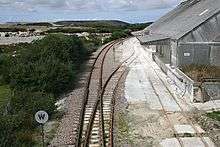Nanpean
Nanpean (Cornish: Little Valley) is a village in the civil parish of St Stephen-in-Brannel in Cornwall, United Kingdom.[1] The B3279 road runs through the village which is approximately 4 miles (6.4 km) north-west of St Austell in the heart of 'clay country', the china clay mining area of mid-Cornwall.[2]


There are plans to build 150–300 homes as part of the St Austell and Clay Country Eco-town. The plan was given outline approval in July 2009.[3]
History
Nanpean church was built in 1879 dedicated to St George the Martyr. The building has an apsidal chancel, nave and south aisle, and a small bell turret. Nanpean also had a Wesleyan Methodist chapel.[1]
The village has a school, Nanpean Community Primary School[4] The original village school was built in 1898. It was refurbished and extended in 2002 and a further extension was added in 2004.
In the 1930s, Nanpean had a range of businesses, including a cobbler's shop, which also served as a place for local men to discuss important issues of the day. There is a much smaller range of businesses based in Nanpean today.[5]
Nanpean is believed to be the origin of the name of the Nepean River in Australia, via the colonial administrator Evan Nepean.
China clay
Nanpean was one of the most important centres in the clay country for administration, management, processing, research, transport and supply, and the village reflects that economic function. It was a centre supplying the social, religious, Education|educational and commercial needs of an area remote from older settlement centres.[6]
Imerys is a very prominent company in district and it owns most of the china clay pits. It also has a refinery (known as Goverseth) on the outskirts of the village and has its mineral selling facilities in Nanpean.[7]
Transport
The Newquay and Cornwall Junction Railway (a branch from the Cornish Main Line at Burngullow) opened as far as Nanpean in 1869 and was extended in 1874 to connect with the Par to Newquay branch at St Dennis Junction.[8] The railway only carried goods traffic so there was never a passenger station at Nanpean; the southern section remains open for china clay trains.
Sport
Nanpean Rovers is an association football team formed in 1901. Since 1936 it has played in a reclaimed china clay pit now known as the Victoria Bottoms Playing Field. The club played in the East Cornwall Premier League from 1973 through to 2017 and were champions in 1994–95 and 1996–97 seasons. The team finished in the bottom two for their final nine seasons in the league and withdrew at the beginning of the 2017–18 season. Nanpean also reached the final of the Cornwall Senior Cup in 1960 and 1997 losing to St Blazey and Falmouth Town respectively.[9]
References
- GENUKI website; St Stephen-in-Brannel; retrieved April 2010
- Ordnance Survey: Landranger map sheet 200 Newquay & Bodmin ISBN 978-0-319-22938-5
- "Drinnick and Nanpean". ECO-BOS. Retrieved 7 November 2010.
- Nanpean school website; retrieved April 2010
- Trethewey, M. (2011). "Memories of Nanpean". Old Cornwall. XIV (4): 69–73. Archived from the original on 2011-08-08. Retrieved 2011-06-18.
- "Nanpean (Hensbarrow area)" (PDF). CORNWALL INDUSTRIAL SETTLEMENTS INITIATIVE. Cornwall Historic Environment Service. Retrieved 2011-06-18.
- "Imerys | World Leader in Mineral-Based Specialties". www.imerys.com. Retrieved 2020-07-09.
- R Barton; History of the Cornish China-clay Industry; published by Bradford Barton; 1966; ISBN 0-85153-038-9
- Deacon, Dave. "Former Senior Cup winners (sic) quit League after 44 years". Cornwall Independent (11028). p. 56.
External links
![]()